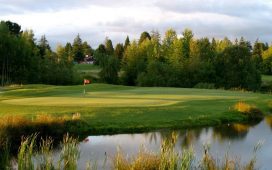Since its 1999 opening, Bandon Dunes Golf Resort has been a model for the golf industry. It now has an unprecedented five courses ranked among the top 10 on Golfweek’s Best Resort Courses list.
Behind the scenes, however, it also has been a model for the industry with its all-encompassing conservation program that reflects the values of the resort’s ownership. The latest example is a new partnership between Bandon Dunes, The Freshwater Trust and Yeti to sharply reduce the number of plastic water bottles used by resort guests.
The conservationists’ ethos that permeates the Bandon Dunes staff trickles down from the resort’s visionary founder, Mike Keiser, whose first business venture was Recycled Paper Greetings, which he co-founded in 1971. But Keiser said his leave-no-trace environmentalism began long before his business career.
“My dad was an Eagle Scout who taught myself and my three brothers that whenever you go to a camp, leave it in better shape than it was when you arrived,” Keiser recalled.
Bandon Dunes’ partnership with The Freshwater Trust and Yeti is the latest and most visible reflection of Keiser’s conservationism. Jeff Simonds, Bandon Dunes’ director of resort operations, said the resort’s guests have consumed 650,000 plastic water bottles over the past five years. The resort’s staff wants to drive down that number.
Since last year, Bandon Dunes has installed 14 new water-refill stations across the property. When golfers arrive at the resort, they’re given the option to buy a handsome, logoed, 18-ounce Yeti Rambler. Simonds anticipated 20% early adoption by guests, and said Yeti sales are slightly exceeding that goal.
“We’ve always tried to be very sensitive toward our impact on the environment,” said Simonds, now in his 18th year at Bandon Dunes. “We’ve been focused on what we can do as a resort without asking our guests to play a role in it. The biggest change we’ve initiated is we’re asking our guests to be active with us.”
Keiser noted that the only other time the resort’s staff had talked about the environmental efforts was when guests checked in at Bandon Preserve, the resort’s 13-hole short course, and were told that proceeds from their greens fees would fund the Wild Rivers Coast Alliance. The WRCA is the resort’s grant-making arm that funds projects along Oregon’s South Coast that yield what Simonds called “triple-bottom-line results” – benefiting conservation, community and the economy.
“It’s a great way to connect Bandon Dunes to the South Coast and make a bigger impact on where we live,” Simonds said.
Keiser has committed his own money to this initiative, gobbling up a 2,000-acre watershed in remote Pistol River, Ore., 70 miles south of Bandon Dunes. He didn’t do it to build more golf, but simply to protect the land and the native salmon.
“It’s such a gorgeous riparian area,” Keiser said. “I think of it as an amenity for the very few golfers who are driving (U.S.) 101, in which case they’ll know, ‘My greens fee helped buy this.’”
(These sorts of initiatives aren’t unique to Bandon Dunes. At Sand Valley Golf Resort in central Wisconsin, Keiser said he is “using greens fees, in part, to buy up land under the title of The Nature Conservancy.” The goal is to help the Wisconsin Department of Natural Resources create six wildlife areas in the Central Sands Region over the next 10 to 20 years.)
At Bandon, The Freshwater Trust-Yeti program is just the latest example of the culture of conservation that has permeated the resort for more than two decades.
Consider this fact: Even with six golf courses, most of the resort’s land—1,500 acres of the 2,525-acre property—remains unmanaged. Only 600 acres are irrigated, and a water-recycling system that has been in place from the outset saves 50,000 gallons of water daily during the peak season. The hardy fescue turf that fosters the creative ground game has the added benefit of requiring minimal fertilizing.
The mere presence of golf required the costly elimination of gorse, which looks lovely when blooming, but is rated the second-most noxious weed in Oregon. It’s also a sore spot for locals; gorse is highly flammable and fueled fires that burned down the town of Bandon in 1914 and again in 1936.
Elsewhere at the resort, Bandon Dunes’ staff is looking for ways to reduce the resort’s carbon footprint. The resort’s energy supply is 85% renewable and 95.2% carbon-free. An energy grid that includes 188 solar panels offsets more than 10 residential utility customers. A resort-wide transition to LED lighting and on-demand water heaters has bolstered energy efficiency, and waterless urinals are saving 128,000 gallons annually.
“We’re showing that you can run a golf resort, and you don’t have to take from the environment, you can give back,” Simonds said.






